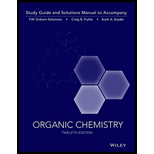
Concept explainers
Interpretation:
The reason behind the formation of a conjugate diene by dehydrohalogenation of 1,2-dibromocyclcohexane, when, generally, dehydrohalogenation of dihalides leads to
Concept introduction:
舧 Electrophiles are electron-deficient species, which has positive or partially positive charge. Lewis acids are electrophiles, which accept electron pair.
舧 Nucleophiles are electron-rich species, which has negative or partially negative charge. Lewis bases are nucleophiles, which donate electron pair.
舧 Free radical is an atom, molecule, or ion that has an unpaired electron, which makes it highly chemically reactive.
舧 Substitution reaction: A reaction in which one of the hydrogen atoms of a hydrocarbon or a
舧 Elimination reaction: A reaction in which two substituent groups are detached and a double bond is formed is called elimination reaction.
舧 Addition reaction: It is the reaction in which unsaturated bonds are converted to saturated molecules by the addition of molecules.
舧 The reaction in which the halide group and hydrogen group are removed to form
舧 The reaction in which hydrogen is added to the compound in the presence of catalyst is known as hydrogenation.
舧 The number of moles of hydrogen absorbed will be equal to the number of double bonds.
舧 Alkynes are synthesized by dehydrohalogenation of dihalides using a strong base and a strong nucleophile via E2 elimination reaction.
舧 The linear nature of the
Want to see the full answer?
Check out a sample textbook solution
Chapter 13 Solutions
Organic Chemistry, 12e Study Guide/Student Solutions Manual
- Addition of HBr to allene (CH2 = C = CH2) forms 2-bromoprop-1-ene rather than 3-bromoprop-1-ene, even though 3-bromoprop-1-ene is formed from an allylic carbocation. Considering the arrangement of orbitals in the allene reactant, explain this result.arrow_forwardDehydrohalogenation of 1-chloro-1-methylcyclopropane affords two alkenes (A and B) as products. Explain why A is the major product despite the fact that it contains the less substituted double bond.arrow_forwardAddition of HBr to allene (CH2=C=CH2) forms 2-bromoprop-1-ene rather than 3-bromoprop-1-ene, even though 3-bromoprop-1-ene is formed from an allylic carbocation. Considering the arrangement of orbitals in the allene reactant, explain this result.arrow_forward
- cis-1-Bromo-4-tert-butylcyclohexane and trans-1-bromo-4-tert-butylcyclohexane both react with sodium ethoxide in ethanol to form 4-tert-butylcyclohexene. Explain why the cis isomer reacts much more rapidly than the trans isomer.arrow_forwardFree-radical chlorination of hexane gives very poor yields of 1-chlorohexane, while cyclohexane can be converted to chlorocyclohexane in good yield. How do you account for this difference?arrow_forwardElimination of HBr from 2-bromobutane affords a mixture of 1-butene and 2-butene. With sodium ethoxide as base, 2-butene constitutes 81% of the alkene products, but with potassium tert-butoxide, 2-butene constitutes only 67% of the alkene products. Offer an explanation for this difference.arrow_forward
- Account for the fact that addition of HCl to 1-bromopropene gives exclusively 1-bromo-1-chloropropane.arrow_forwardAddition of HBr to allene (CH2=C=CH2) forms 2-bromoprop-1-ene ratherthan 3-bromoprop-1-ene, even though 3-bromoprop-1-ene is formed froman allylic carbocation. Considering the arrangement of orbitals in theallene reactant, explain this result.arrow_forwardFree-radical chlorination of hexane gives very poor yields of 1-chlorohexane, while cyclohexane can be converted to chlorocyclohexane in good yield. What ratio of reactants (cyclohexane and chlorine) would you use for the synthesis of chlorocyclohexane?arrow_forward
- Draw an approximate reaction-energy diagram showing the curves for the two possible pathways for ionic addition of HBr to 1-methylcyclohexene. (a) Formation of the major product, 1-bromo-1-methylcyclohexane, and (b) formation of the minor product, 1-bromo-2-methylcyclohexane. Point out how these curves show that 1-bromo-1-methylcyclohexane should be formed fasterarrow_forwardPoly and B-Ryan are asked by their supervisor to synthesize (1R,3R)-1-chloro-1,3- dimethylcyclopentane. To accomplish their syntheses, Poly chooses to start from a trisubstituted alkene while B-Ryan chooses to start from a disubstituted alkene isomer. Poly's synthesis provides a mixture of isomers while B-Ryan's provides two stereoisomers. Both synthetic approaches are shown below. Me Me, Me, .CI Me HCI A B-Ryan's Synthesis Me 'CI + 75% 25% Ме Me Me Me... Me B Me C HCI A Poly's Synthesis -Me Ме 'CI 'CI + + Me.. .CI + a trace mixture ; of constitutional D Ме chloroalkane isomers Using your mechanistic knowledge of alkene reactions: (a) Explain the selectivity (regio and stereo) observed in B-Ryan's synthesis. (b) Propose a mechanism that accounts the formation of isomer C in Poly's synthesis. (c) Draw the major stereoisomer(s) formed in the "trace mixture of constitutional isomers" isolated in Poly's synthesis. 9.arrow_forwardα-Terpinene, C10H16, is a pleasant-smelling hydrocarbon that has been isolated from oil of marjoram. On hydrogenation over a palladium catalyst, α-terpinene reacts with 2 molar equivalents of H2 to yield a hydrocarbon, C10H20. On ozonolysis, followed by reduction with zinc and acetic acid, α-terpinene yields two products, glyoxal and 6-methyl-2,5- heptanedione. (a) How many degrees of unsaturation does a-terpinene have? (b) How many double bonds and how many rings does it have? (c) Propose a structure for a-terpinene.arrow_forward
 Organic ChemistryChemistryISBN:9781305580350Author:William H. Brown, Brent L. Iverson, Eric Anslyn, Christopher S. FootePublisher:Cengage Learning
Organic ChemistryChemistryISBN:9781305580350Author:William H. Brown, Brent L. Iverson, Eric Anslyn, Christopher S. FootePublisher:Cengage Learning
